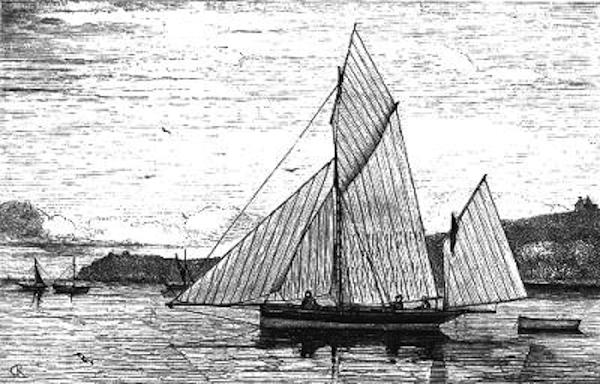The generous hospitality of the Dutch OGA to the Gaffers during the summer celebrations, 2014, reminds us of how much The Netherlands has always had to offer the adventurous yachtsman. This review of the cruise of the ‘Widgeon’, undertaken by a young man 140 years before, might make modern-day sailors think.
The cruise of the ‘Widgeon’ describes a cruise made in a 10 ton, 35’ yawl in 1874. The owner, Charles E. Robinson, was a Cambridge undergraduate who later became a lawyer. This is a well written book, easy to read, and penned by someone who knows a lot about sailing. Robinson decided that a cruise from Poole to Hamburg would be an amusing way to spend the summer holidays. We don’t know how old the ‘Widgeon’ was, but the fact that she had recently had an extensive overhaul, including a new keel, suggests that she was not new. The young skipper took with him a paid hand who lived in the forepeak. This cannot have been very comfortable, especially as we are told that the forehatch leaked in bad weather. There is much in the book that is recognisable here, sailing familiar waters in a boat that is not so different from many of today’s gaffers. There are sailing trading vessels and fishing boats around everywhere, but after the Solent, hardly any yachts are seen until they reach Hamburg. There are so many period touches that suddenly remind you how long ago it all was. For example, the Solent forts, then only a few years old, are ‘bristling with guns’. There is no need to worry about the weather forecasts, since there are none.
The trip is a fairly leisurely affair, down to Dover (before the modern harbour, built in 1909), across to Ostend and through the Dutch inland waters. What is surprising is how well they get by without modern conveniences. For example, a man rows out from the shore to deliver a telegram while they are sailing in Southampton Water. They never seem to have any difficulty in finding a local pilot to stay aboard for a few days to guide them through difficult waters, which is just as well as the charts at times don’t seem much help. Getting along the canals when the wind is unfavourable is not a problem; just hire a man with a horse for a few shillings a day to tow the boat. Occasionally they get a tug from a passing steam boat. The Dutch coastal waterways, at that time wide open to the North Sea, are a treacherous mass of constantly shifting tidal sands that can only safely be navigated with local knowledge. The ancient towns are protected by low dykes, but the risk of disastrous flooding is never far away and is a very real memory for many local people.
Many of the quaint mediaeval buildings Robinson admires are still there today. He finds the old church tower at Leeuwarden is leaning dangerously, due to subsidence of the sandy soil which started while it was still under construction. He climbs the tower to admire the view of the surrounding countryside. He is alarmed by the huge cracks in the masonry, and is concerned that there is no sign of any repair work. He thinks that the tower will soon fall and that nothing can now save it. Possibly his words spurred the Dutch into action but probably not. However there must have been some maintenance done, as Leeuwarden church tower is still standing, and still leaning just as much 140 years later. Eventually the ‘Widgeon’ gets to Hamburg, and takes part in a yacht race. Later they try to start on the long haul home but run into a strong contrary wind. The solution is simple: Robinson sells the previously much loved ‘Widgeon’ in Hamburg, gets the steamer home and buys a new yacht in Poole for the next season. Not something many of today’s undergraduates could afford on their student grants.
Review by Mike Beckett, skipper of ‘Bonita’ and participant in the Dutch OGA Anniversary Tour, 2014
